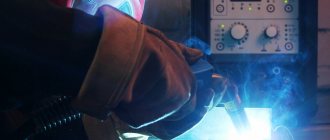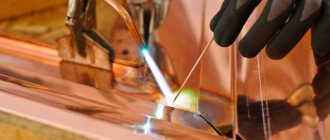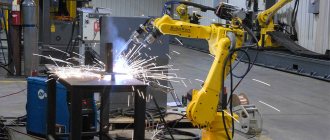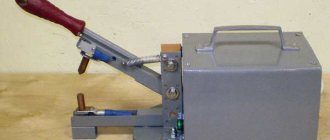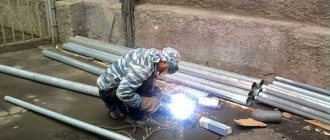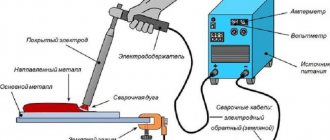Pulse welding - what is it? In essence, this is ordinary electric arc welding, during which additional short-term pulses are applied. Please do not confuse this type of welding with spot welding. Pulsed spot welding and pulsed arc welding are two radically different methods of joining metals.
But what if you want to try this method of joining metals in your practice, but do not want to spend a lot of money on buying a high-quality welding machine? There is a solution! You can make homemade pulse welding. Pulse welding can be assembled on your own in one and a half to two hours, and all components are inexpensive. In this article we will tell you in detail how to make pulse welding with your own hands and what is our experience in using a homemade welding machine.
Features of pulse welding
This type of welding is capable of joining such capricious metals as copper alloys, steel and many other non-ferrous alloys, including aluminum. Pulse welding is excellent for complex butt welds when joining metal workpieces with thick edges.
Historically, pulsed welding was invented and developed as a competitive method to electric arc technology, which has certain disadvantages in terms of productivity and weld quality.
general information
Let's start with the terms, because difficulties often arise with them. Often, when reading articles on this topic or when communicating with other people, we hear the word “invector,” but this is a mistake in the word. The correct term is "inverter".
Speaking about this equipment, some people believe that “pulse inverter machine” and “pulse welding machine” are synonyms. This statement is false, because Pulse welding is used in another type of welding.
Now let's understand the concept. An inverter welding machine is one of the types of equipment for welding. In it, due to the inverter, arc power is provided.
Inverter devices are common and in demand on the market. The first prototype of an inverter device appeared at the end of the 20th century. Soon engineers significantly improved its design; it became convenient for everyone.
The essence of the process
The principle of pulse welding.
In short, this is a process of sequential melting of the metal of the workpiece at certain points with the next stage in the form of coating.
The main element of this process is the so-called low-power pilot arc, which continues to operate in stops between repeating pulses and transmits the pulse current only partially.
This arc has virtually no effect on the metal between pulses; it burns perfectly and steadily in space. The second state of the same arc is pulsed, which melts the metal at the points of application.
The ratio of currents from the arc in different states - pulsed and standby - must be correct, which can speed up welding and improve the quality of the seam.
The possibilities of classical gas-shielded arc welding are greatly expanded if the metal is melted under the influence of a pulsed arc.
Its main feature is a special mode for turning on and off the arc, which is determined by the program depending on the nature of the metals of the workpieces being connected, the thickness of their edges and the position of the seams in space.
Short pulses are produced using the energy of a special battery, which is pre-charged from an electrical circuit. The main technological feature and advantage of the method is the ability of pulse welding to form permanent joints of metals with completely different compositions.
Equipment for pulse welding requires special equipment - this is a special specialized pulse welding machine with certain consumables. The pulse machine generates dosed welding pulses.
Consumable materials include various types of electrodes - consumable and non-consumable.
The pulse welder includes the following elements:
- low frequency rectifier;
- another high-frequency rectifier;
- welding inverter device;
- transformer;
- electronic control unit - plateau;
- working shunts.
Electrical diagram of a pulse welding device.
The two pulse welding methods are determined by the choice and use of electrodes:
- using non-consumable electrodes;
- using consumable electrodes, eliminating the disadvantage of the process in the form of splashing drops of molten metal.
One way or another, this is a controlled, repeating process of transferring molten consumable metal in a protective gas environment.
Here's how it happens:
- A drop of molten metal from the consumable wire is separated and moved to the workpiece under the influence of a powerful impulse.
- Immediately after this, the strength of the welding current drops to a level that can only support the arc - the arc becomes “standby”, of low power.
- The process of cooling the metal in the weld pool begins instantly.
- An exact repetition of the same cycle of droplet transfer under a pulse begins, with a drop in current, cooling, etc.
From the point of view of the electrical component of the pulse welding process, the device uses the transformation of mains voltage into rectified direct voltage, after which it turns into voltage with a high frequency.
Why do you need a battery charge controller?
The main function of a battery charging controller is to regulate the recovery of energy losses. First, the conversion of electrical energy into chemical energy is monitored, and then it is accumulated to be used when necessary for certain devices and mechanisms.
You can make such a device with your own hands, which home craftsmen successfully do by selecting the limits in devices up to 15 Volts.
There are these types of charging controllers depending on their application:
- For equipment used in everyday life;
- For mobile devices and gadgets;
- For renewable energy sources.
In addition, the controllers can be used for various solar panels and wind blowers. The upper voltage limit in such devices is usually 15 V, and the lower limit is 12 V.
The use of a battery charge controller is also suitable for mobile devices. There is no particular difference between a device for a smartphone, a feature phone or a tablet.
Technical nuances
Before starting work, the energy receiver must be connected to the power supply to charge it to the required level. Pulse welding itself takes very little time, since it uses the energy stored in the receiver. This kind of welding can be done with your own hands; it is not at all overly complicated.
With this method, the unpleasant phenomenon of splashing droplets of molten metal is perfectly controlled and minimized. There is an excellent opportunity to produce high-quality welds almost at home.
Seams are formed due to the melting of individual portions of metal followed by coating.
The most important point is the correct setting of the pulse and pilot arc modes. If the mode is correct, the process will go quickly, correctly and, most importantly, safely, without any craters in critical joint areas.
Pulsed DC welding
The rigidity of the regime is a technological feature of this method. It's all about the pulse duration. If you change it, all welding parameters will change.
One of the important advantages is the ability to control and minimize metal crystallization. You can change the shape of the weld pool. Additionally, the risk of weld deformation can be controlled and reduced.
This method is often used to join metal with edge thicknesses greater than 3 mm.
Advantages of a homemade device
In addition to the price, a homemade pulse welding machine has many other advantages over models sold in stores. The first advantage is low current consumption. If you plug an ordinary device from a store into a household outlet at your dacha and weld a gate, for example, you will soon receive electricity bills and be unpleasantly surprised. In addition, connecting such a device to a household outlet is simply dangerous; the machines may not withstand such power.
Don’t forget about the dimensions of purchased devices. It is simply impossible to calmly carry them in your hands from place to place. In factories, welders simply use very long wires so as not to move such a device around the workshop. However, the price for such wires is very high, and we don't think you'll want to spend an extra $100 on cables. But the homemade device weighs little and can be easily moved.
Also, purchased devices have their own production capabilities, and they rarely exceed 80%. And often they are at around 50%. This means that such a device simply cannot reveal its full potential. This happens because a large and technically complex welder gets very hot and takes a long time to cool down. For this reason, you will also not be able to cook for more than 2-3 minutes at a time.
A homemade welder assembled according to our diagrams does not have such disadvantages. There are no reactive currents in it, so almost all electrical energy is used. You can easily connect such a welder to a home outlet and not worry about electricity bills and possible operating time. After all, the power of our homemade device is only slightly greater than the power of a regular iron.
Using a homemade pulse welding machine, you can cook for more than 20 minutes, which is definitely longer than the allotted 2-3 minutes for the machine in their store. And the weight of such a homemade device does not exceed 10 kilograms. This is what the home handyman needs.
What other advantages are there? Well, you can reduce the cost of the design even more at the assembly stage. For example, to use wires with a smaller cross-section as welding cables, 12 square millimeters is enough. And to power the device, you can use wires from household extension cords.
Classification of species
Pulse welding is divided into four types:
- capacitor using devices with a huge range of current. Excellent for welding aluminum parts;
- rechargeable, which uses devices with alkaline batteries, copes well with short circuits in the network;
- inertial using the kinetic energy of a powerful flywheel;
- electromagnetic with the production of mechanical energy using a magnetic field. The elements are attached by magnetic forces combined with high pressure.
Algorithm of actions
This is one of the best types of welding overall. There is no spattering, no lack of fusion is formed, you can cook in any position, electrodes are used very sparingly. The seams are formed of exceptional quality without any burns.
Capacitor welding scheme.
The principle of operation of a welding inverter in combination with pulse technology is as follows: transfer of the electrode metal into the weld pool while simultaneously regulating the current.
It all starts with the formation of a drop of metal at the end of the electrode, which, when the current increases, enters the weld pool. Now this hot moment should be replaced by a cold stage with the cooling of the metal. This can happen many times.
The electrode wire must be well heated. This is especially important at low current values.
A pulse welding machine is an extremely versatile device: it can also be used in a gas environment to join metal parts of very different thicknesses and configurations.
These devices are very easy to use with clear adjustments for proper and fine tuning. They are usually equipped with good software support, which makes them even more effective in all respects.
Elements of the electrical circuit of inverter devices
The welding inverter device consists of the following basic elements:
- rectifier for alternating current coming from a regular electrical network;
- an inverter unit assembled on the basis of high-frequency transistors (such a unit is a generator of high-frequency pulses);
- a transformer that lowers the high-frequency voltage and increases the high-frequency current;
- high-frequency alternating current rectifier;
- working shunt;
- electronic unit responsible for controlling the inverter.
Example of an inverter circuit diagram (click to enlarge)
The rectifier and inverter units of the equipment become very hot during their operation, so they are installed on radiators that actively remove heat. In addition, to protect the rectifier unit from overheating, a special temperature sensor is used, which turns off its power supply when it reaches a temperature of 90 degrees.
The inverter unit, which is essentially a generator of high-frequency high-power pulses, is assembled on the basis of transistors connected like an “oblique bridge”. High-frequency electrical pulses generated in such a generator are sent to a transformer, which is necessary to lower their voltage.
The most common transformers used to equip welding inverters are devices with the following characteristics: primary winding - 100 turns of PEV grade wire (0.3 mm thick); 1st secondary winding – 15 turns of copper wire with a diameter of 1 mm; 2nd and 3rd secondary windings - 20 turns of copper wire with a diameter of 0.35 mm. All windings are carefully insulated from each other, and their exit points are protected and sealed.
Internal structure of the welding inverter
The output rectifier of the welding inverter receives a high frequency current. Simple diodes cannot cope with converting such current into direct current. That is why the rectifier is based on powerful diodes with high opening and closing speeds. To prevent overheating of the diode block, it is placed on a special radiator.
A mandatory element of any welding inverter is a high-power resistor, which provides the device with a soft start. The need to use such a resistor is explained by the fact that when the power is turned on, a powerful electrical impulse is supplied to the equipment, which can cause failure of the diodes of the rectifier unit. To prevent this from happening, current is supplied through a resistor to the electrolytic capacitors, which begin to charge. When the capacitors reach full charge and the device enters normal operating mode, the contacts of the electromagnetic relay close and the current begins to flow to the rectifier diodes, already bypassing the resistor.
Output chokes on the welding inverter board
The operation of all elements of such a welding machine, characterized by compact dimensions, low weight and high power, is controlled by a special PWM controller. Electrical signals are supplied to the controller from an operational amplifier, which is powered by the output current of the inverter itself. Based on the characteristics of these signals, the controller generates corrective output signals that can be supplied to the rectifier diodes and transistors of the inverter unit - a generator of high-frequency electrical pulses.
In addition to the basic ones, modern welding inverters also have a whole list of useful additional options. Such characteristics, which greatly facilitate the work with the device and make it possible to obtain high-quality, reliable and beautiful welded joints, include forcing the welding arc (fast ignition), anti-sticking of the electrode, smooth adjustment of the welding current, and the presence of a protection system against overloads.
Circuit board with the main elements of the inverter
The main advantages of the method
Advantages of pulse welding:
- The first thing is the excellent quality of the weld. Let us immediately note that pulse devices are very expensive things. But they are worth it and will definitely pay off all costs in the future.
- Pulse welds everything from steel to aluminum.
- A minimum of additional tools and consumables are required.
- No metal spattering.
- There are no burns or failures of fusion.
- Ability to control the arc.
- Excellent ability to control the metal transfer process.
- Economical consumption of materials, including welding wire and electrodes.
- Easy seam cleaning at the end.
- Easy to perform even for beginners.
Drawing of a pulse welding device.
Today, this method has only one competitor in popularity and efficiency - semi-automatic welding. It is characterized by high productivity and, importantly, process continuity.
But a serious drawback is metal spattering, which results in the loss of up to 30% of the material. In addition to losses, these spatters must be cleaned after welding, which is very difficult and spoils the appearance of the weld. Pulse welding eliminates such a problem.
The main area of application of the method is the installation of pipelines of the most critical type, where the strength of the seam with a firmly formed back bead without finishing stripping is especially important.
This method has only two disadvantages:
- it is not suitable for large welding areas;
- serious cooling of the inductor is always necessary.
AC
Semi-automatic welding inverter
This device has a simple design. In essence, this is a step-down power transformer with a certain number of secondary winding terminals. Such devices are divided into:
- semi-automatic devices operating using an electrode wire in an inert and protective gas environment;
- inverters for argon manual electric welding using non-consumable tungsten electrodes;
- equipment for carrying out work using the contact method.
Pobeda AC 250 (MMA) – thermal protection function with overheating indication
This inverter-type device produces an even seam when connecting elements and steel structures. Suitable for use as a construction aid in a country house or in a private workshop.
The unit is suitable for welding non-ferrous, ferrous metals and steels. The small handle and light weight make it easy to carry the Pobeda around the work site. The model is equipped with an effective cooling system and a thermal protection function with overheating indication.
This device has anti-stick and hot start functions. The inverter has manual arc welding. Operates with a power of 5 kW, electrode diameter from 1.6 to 5 mm. There is one phase when feeding. The open circuit voltage is 65 W.
The weight of the device is 4 kg. Due to its lightness, the inverter device is easy to carry around the work site. The kit includes a carrying strap, an electrode holder, instructions and a ground terminal. The reliability of the seam is ensured by a high-quality arc.
Pros:
- price;
- high-quality assembly;
- good seam.
Minuses:
short wires.
BIZON 205 PN-3 (MMA) – does not heat up during operation
This large Russian manufacturer produces equipment and materials for construction and repair, as well as electric hand tools.
The brand has been producing inverter devices since 2005. Protection against short circuits and overheating, the ability to operate at low voltage, stable arc support and ease of ignition make these devices very popular.
The inverter has one power phase. The operating power is 5 kW. Duration of switching on at maximum voltage 30%. The unit can be used at temperatures from -10 to 40 °C. Suitable even for welding structures in northern conditions. The kit includes a cable with an electrical holder, a ground cable and clamps.
Pros:
- does not heat up during operation;
- easy;
- compact;
- good seam quality;
- price.
Minuses:
there is no protection on the board in the case.
Aurora STICKMATE 205 (TIG, MMA) – compact and lightweight
This brand is from Russia, but its products are made in China. The catalog is presented with semi-automatic inverters for industrial and home use. All of them operate in a network with a voltage of 220 V and 380 V.
Such models are suitable for welding seams of copper, cast iron, and aluminum products. The manufactured devices operate on alternating current in an argon environment.
A special feature of this unit is manual arc and argon arc welding. The maximum generated voltage is 200 A.
The diameter of the electrodes is from 1.2 to 1.6 mm. There is a hot start and anti-stick function. The open circuit voltage of this inverter is 58 V. Duration of switching on at a maximum current of 40%.
Arc force and VRD function are present. The output voltage type is variable. The device operates at temperatures from -25 to +50 °C. Suitable even for very hot climates. The weight of the welding machine is 3 kg. The kit includes one ground clamp, two cables, and an electrode holder.
Pros:
- operates from -20 to +50 °C;
- small and dimensions;
- price.
Minuses:
sometimes overheats after 6 hours of operation.
ESAB LHN 200i Plus (TIG, MMA) – regulation of welding current frequency
The device has a hot start function and arc force. Open circuit voltage is 77 V. Duration of switching on at a maximum current of 40%.
The device weighs almost 6 kg. Produces a choice of manual and argon welding arcs. The diameter of the electrodes is from one to 4 mm. Operates at temperatures from -20 to 45 °C.
And the device has a well-thought-out cooling system, which includes two miniature fans. The inverter can be used to make seams with any types of electrodes. Hot start technology ensures stability and reliable ignition of the arc.
The frequency of the welding current can be adjusted during welding. Using this device, you can connect elements made of copper, magnesium, carbon steel, stainless steel, titanium, and alloy steel. Suitable for pipe welding.
Pros:
- two types of welding;
- price.
Minuses :
heavy weight.
DIY pulse welder
The design of the welding machine makes it possible to make it at home for domestic use. The components are easy to buy, there are no problems here. But we must not forget about some nuances.
A special focus is on transistors, because they break down and fail most quickly. Don't skimp on them, but buy four high-quality transistors.
Before you start working, you need to think about and calculate the strength of the welding current and the power of the device. There are a huge number of examples with similar calculations on the Internet; they can help in developing the right solution.
How to choose a welding inverter
For household inverter units, the voltage must be 220 V
Before purchasing an inverter, you should find out what value the equipment power will have - the rated welding current. The manufacturer always writes such data in the model passport.
Such parameters indicate the voltage at which the welding machine will not overheat and operate at its maximum capabilities. This takes into account periods of rest, work, and compliance with the duration of switching on.
If the device is not purchased for regular use, you can choose a unit with a power of 160 to 200 A. Such models have a standard set of functions
The mains voltage at which this equipment will operate is also important. For household inverter units it is 220 V
Single-phase networks are divided by type into stable and unstable. The first has the following features. The voltage jumps from 180 to 254 V.
This category includes industrial and domestic systems. The welding device will work under these conditions, but with slight deviations. An unstable network appears when using an extension cord. It can be found in garden plots or garages.
The tension in this situation deviates from the norm. If the unit is purchased for use in similar conditions, then it is better to choose a model with a wide operating voltage range.
